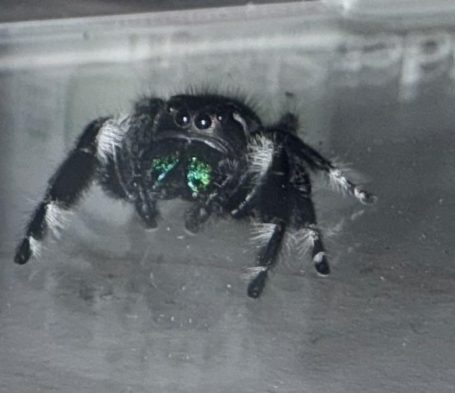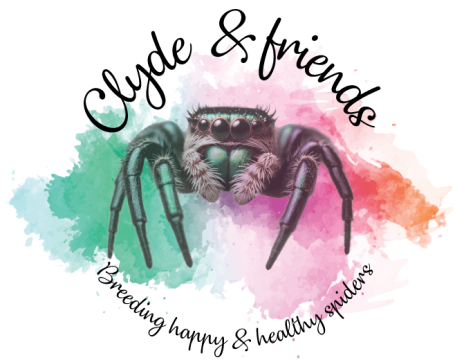
How to care for your jumping spider
Enclosures:
The enclosure needs to be arboreal - more height than width. Front doors on enclosures are the best suited for jumping spiders. This stops hammocks your spider may have made to moult/rest in being broken. Adults are usually kept in a 15x20x10cm at the least. Make sure the enclosure is cross ventilated to ensure the spider is getting enough air flow. Spiderlings are often kept in a smoothie/deli cup with a mesh top/lid to allow airflow. They are kept in these until they are around I6/I7.
Instar:
Instar are the amount of moults the spider has had. I don’t usually sell anything smaller than an I4, so I can ensure the spiders are well established & healthy before selling.
Feeding:
So what to feed your spider depends on the size of them. So I feed I4-I5 flightless fruit flies. I5-I7 I feed green bottles. I7+ get fed blue bottle flies. Every breeder is different, this is just what I do personally. Feed every 2-3 days. If your jumper is looking slightly plump wait to feed until they have slimmed down a bit or moulted. You can feed jumping spiders crickets, but please watch them! Crickets can/do bite. Which can be lethal to jumping spiders. If your jumping spider hasn’t eaten the cricket within 24 hours of them being in there, please remove the cricket to prevent potential injury to your jumping spider.
Water:
Lightly mist your jumping spider every other day. This will need to be adjusted if it’s hot however, to every day.
Enrichment:
Add ledges, hides, leaves & deco to try to mimic their natural environment.
Heat:
25 degrees during the day, but you can drop it to 22 degrees at night to simulate their natural environments. This will help them thrive. Heat mats will also help humidity, all the species of jumping spider I breed do require heat & humidity. They like the humidity to be 70%. You can purchase a hygrometer to get accurate readings of the humidity levels. Do not put a heat mat into the enclosure. The heat mat should be placed either behind or to the side on the wall of the shelf where you keep your spider, but with a gap between. This is because it will allow your spider to move away/to the heat if it needs/wants to. With electric heat mats you must get a thermostat so you can control the temperature. You do not want these heat mats on full temperature as you can cause your spider to become dehydrated or worse case scenario cooked alive. Thermostats work by plugging them into a socket, then the heat mat gets plugged into the thermostat (so you can set the temperature limit). You then put the temperature probe between the heat mat & the enclosure so it can detect the temperature. Once it goes over 25 degrees it will automatically turn the heat mat off. When the sensor detects the temperature has dropped it will then automatically turn the heat mat back on. Making sure your spider has the perfect temperature day/night. Plus keeping your mind at ease that your spider is okay & that your house isn’t at risk of being burnt down.
Lighting:
Jumping spiders need at least 12 hours of light a day. This is to simulate their natural environment. I use LED lights in white as this is the closest to their habitat. Using lighting will help your jumping spider hunt & know night from day. It’ll help them thrive, which is the most important thing.
Do jumping spiders bite:
In short, yes they can bite. Usually it’s a mistake if they bite as they may have mistaken your finger or hand as food. However they can bite if they feel threatened.
Molting:
Like most reptiles & insects, spiders do molt (shed) their exoskeleton, as they grow. Eating can impact on how often they molt. How frequently they do depends on how much they eat. The more they eat the shorter the lifespan of your jumping spider. If your spider has gone into their hammock & hasn’t come out for a few days, it is likely that they are molting or heading into a molt. Offer them water, by misting the sides of their enclosures (lightly). They will normally stay inside their hammocks for days to weeks, to ensure their new exoskeleton has hardened up. The spiders are very vulnerable during molting, so please be very careful & mindful during this time. Do not mist your spider directly at anytime, but especially during this time as this can drown them.
Book lungs:
These are found underneath their abdomen. Their book lungs are what they breathe out of. They have 2 sets of book lungs, 2 at the top of the abdomen & 2 in the middle of their abdomen.
Sexing jumping spiders:
Jumping spiders are usually sexually dimorphic. Sexually dimorphic - can usually tell the difference by looking at them for certain characteristics. Once mature males will have what looks like commas on their pedipalps.
Pedipalps - second pair of appendages attached to the front of the jumping spiders.
Females are often bigger in size to males once they’re mature. Some species can be sexed from I5 however. You can usually do this by looking at their chelicera (females tend to be pink/purple). Males tend to be blue or green. However sometimes this isn’t correct
Chelicera - Pair of appendages in front of the mouth
Females usually have coloured patterns or off white on the abdomen (again not always the way).
Males tend to be black/brown & white. However there is such a thing as light phase males (white or light males). I have a few of things currently in my collection. Same as there is a thing as dark phase females, again I have a few of these in my collection.
The only way to know for 100% sure if they are male or female is maturity
Laying eggs:
Once a female jumping spider reaches maturity they may lay an egg sac without being paired to a male. This egg sac will obviously be infertile. Due to them not being paired. Your spider may still behave differently during this time however. She may starve herself for a few days afterwards & not leave the egg sac. Or she may abandon them completely & carry on as if nothings happened. She may even eat the egg sac completely. These are all completely normal behaviors. She may even go on to lay more infertile egg sacs
Pairing:
When you introduce a male & female jumping spider & the males do their “dance” to try to seduce the female into having sex with them. If accepted by the female, she will allow the male into her back (top to tail) & he will then turn her abdomen round inserting his pedipalps into her (these have his emboli attached - where he transfers his sperm). If successful your jumping spider will be gravid (pregnant with eggs). You must get the male out reasonably quickly to prevent the female from potentially killing him (this can be done)
Handling:
I personally choose not to handle any of my spiders. However if you do choose to, please remember that handling them benefits you more than the spider. That being said some spiders will tolerate being held. Spiders “paws” are extremely sensitive. They can feel things with these such as, temperature, airflow, movement & vibrations. Remember we’re like aliens to them, so our skin feels super weird to them. Spiders are sensitive to noise due to feeling the vibrations of the noise. Some jumping spiders can get used to being handled. Never force a spider to be handled. If a spider doesn’t want to come out of their enclosure leave them be & try again later or the next day. If they are happy to come out, gently coax them out with a paint brush.
Can you keep jumping spiders together?
Again the short answer is no. Jumping spiders are solitary animals. They can & do eat each other if they are kept with other jumping spiders.
Do they recognise you?
So it is believed jumping spiders do recognise their owners & the vibrations of their voice. I personally do not know how true this is, or if there is scientific evidence of this either. But thought it was worth mentioning
Eyesight:
Jumping spiders have excellent eyesight considering how small they are. They have 8 eyes believe it or not, despite only being able to see 4 of them. Each eye does a different job & can even give the spider nearly a 360 view, meaning they can be watching you even if they are looking directly at you. The 2 pairs at the front, give them a narrow but clear image
©Copyright. All rights reserved.
We need your consent to load the translations
We use a third-party service to translate the website content that may collect data about your activity. Please review the details in the privacy policy and accept the service to view the translations.
